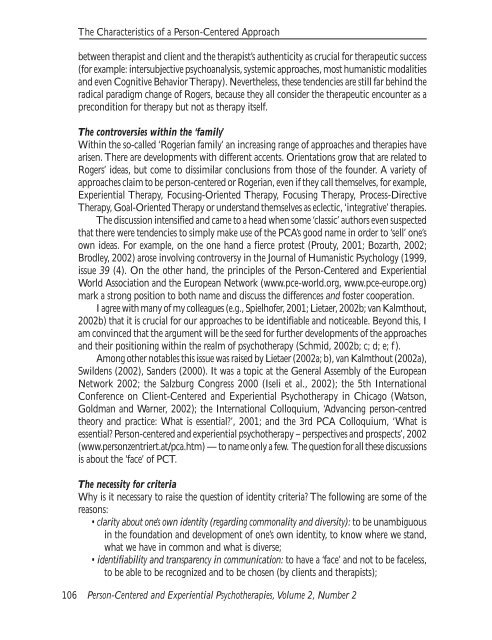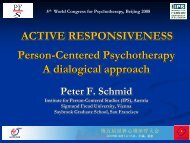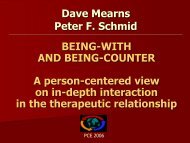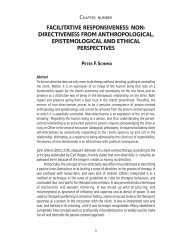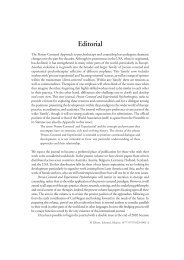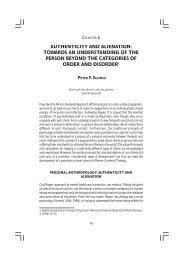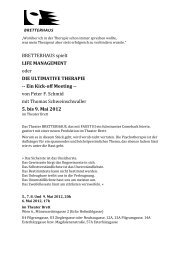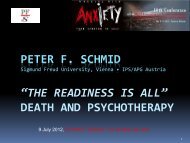The Characteristics of a Person-Centered ... - Peter F. Schmid
The Characteristics of a Person-Centered ... - Peter F. Schmid
The Characteristics of a Person-Centered ... - Peter F. Schmid
- No tags were found...
Create successful ePaper yourself
Turn your PDF publications into a flip-book with our unique Google optimized e-Paper software.
<strong>The</strong> <strong>Characteristics</strong> <strong>of</strong> a <strong>Person</strong>-<strong>Centered</strong> Approachbetween therapist and client and the therapist’s authenticity as crucial for therapeutic success(for example: intersubjective psychoanalysis, systemic approaches, most humanistic modalitiesand even Cognitive Behavior <strong>The</strong>rapy). Nevertheless, these tendencies are still far behind theradical paradigm change <strong>of</strong> Rogers, because they all consider the therapeutic encounter as aprecondition for therapy but not as therapy itself.<strong>The</strong> controversies within the ‘family’Within the so-called ‘Rogerian family’ an increasing range <strong>of</strong> approaches and therapies havearisen. <strong>The</strong>re are developments with different accents. Orientations grow that are related toRogers’ ideas, but come to dissimilar conclusions from those <strong>of</strong> the founder. A variety <strong>of</strong>approaches claim to be person-centered or Rogerian, even if they call themselves, for example,Experiential <strong>The</strong>rapy, Focusing-Oriented <strong>The</strong>rapy, Focusing <strong>The</strong>rapy, Process-Directive<strong>The</strong>rapy, Goal-Oriented <strong>The</strong>rapy or understand themselves as eclectic, ‘integrative’ therapies.<strong>The</strong> discussion intensified and came to a head when some ‘classic’ authors even suspectedthat there were tendencies to simply make use <strong>of</strong> the PCA’s good name in order to ‘sell’ one’sown ideas. For example, on the one hand a fierce protest (Prouty, 2001; Bozarth, 2002;Brodley, 2002) arose involving controversy in the Journal <strong>of</strong> Humanistic Psychology (1999,issue 39 (4). On the other hand, the principles <strong>of</strong> the <strong>Person</strong>-<strong>Centered</strong> and ExperientialWorld Association and the European Network (www.pce-world.org, www.pce-europe.org)mark a strong position to both name and discuss the differences and foster cooperation.I agree with many <strong>of</strong> my colleagues (e.g., Spielh<strong>of</strong>er, 2001; Lietaer, 2002b; van Kalmthout,2002b) that it is crucial for our approaches to be identifiable and noticeable. Beyond this, Iam convinced that the argument will be the seed for further developments <strong>of</strong> the approachesand their positioning within the realm <strong>of</strong> psychotherapy (<strong>Schmid</strong>, 2002b; c; d; e; f).Among other notables this issue was raised by Lietaer (2002a; b), van Kalmthout (2002a),Swildens (2002), Sanders (2000). It was a topic at the General Assembly <strong>of</strong> the EuropeanNetwork 2002; the Salzburg Congress 2000 (Iseli et al., 2002); the 5th InternationalConference on Client-<strong>Centered</strong> and Experiential Psychotherapy in Chicago (Watson,Goldman and Warner, 2002); the International Colloquium, ‘Advancing person-centredtheory and practice: What is essential?’, 2001; and the 3rd PCA Colloquium, ‘What isessential? <strong>Person</strong>-centered and experiential psychotherapy – perspectives and prospects’, 2002(www.personzentriert.at/pca.htm) — to name only a few. <strong>The</strong> question for all these discussionsis about the ‘face’ <strong>of</strong> PCT.<strong>The</strong> necessity for criteriaWhy is it necessary to raise the question <strong>of</strong> identity criteria? <strong>The</strong> following are some <strong>of</strong> thereasons:• clarity about one’s own identity (regarding commonality and diversity): to be unambiguousin the foundation and development <strong>of</strong> one’s own identity, to know where we stand,what we have in common and what is diverse;• identifiability and transparency in communication: to have a ‘face’ and not to be faceless,to be able to be recognized and to be chosen (by clients and therapists);106 <strong>Person</strong>-<strong>Centered</strong> and Experiential Psychotherapies, Volume 2, Number 2


